The 30% Federal Investment Tax Credit: What You Need To Know
The solar industry has shown tremendous growth over the past seven years for a number of reasons: decreasing costs, a clean form of emissions free energy, and an environmental awakening across the globe. In order for the industry to grow in the world's biggest economic market the government provided a tax incentive specifically for homes and businesses to encourage solar adoption.
The strategy behind this support is that one day prices will drop across the board and the tax credit will no longer need to be offered. Currently, it is the biggest incentive offered to make solar more affordable.
What Is The ITC?
The ITC is called two different things. It is called the Residential Renewable Energy Tax Credit as well as the Solar Investment Tax Credit (ITC). Perhaps the best definition comes from the SEIA: The Investment Tax Credit (ITC) is currently a 30 percent federal tax credit claimed against the tax liability of residential (Section 25D) and commercial and utility (Section 48) investors in solar energy property. The Section 25D residential ITC allows the homeowner to apply the credit to his/her personal income taxes. This credit is used when homeowners purchase solar systems outright and have them installed on their homes.
The ITC was created as part of the Energy Policy Act of 2005. In 2008, during the height of the economic recession, the Emergency Economic Stabiliization Act added an eight-year extension. In December of 2015, the ITC was extended yet again, this time for five years. People who want to take advantage of the investment tax credit at the 30% rate have through December 31st of 2019 to do so. After December 31, 2019 the percentage drops to 26% in 2020 and 22% in 2021. After 2022 it drops to 10% for commercial and utility credit while the residential credit drops to zero.
The credit amounts to 30% of expenses, and can be applied to income taxes after home or business owners install solar systems on their properties for up to five years following installation. The tax credit applies to the total expenses related to a solar investment, including the equipment and the installation costs.
Why Is It Important?
2015 saw the largest growth of the solar industry at over 7.4 GW of installed capacity. 2016 is expected to double the year-over-year solar installation total at approximately 15.4 GW. The global market is realizing tremendous growth and political leaders saw that America had to be a technology leader. The industry is on the precipice of more far-reaching levels of adoption so the ITC was extended to make sure that the industry continues on a growing path. In short, it has provided stability and growth to the industry.
The tax credit is the single biggest incentive customers have access to. The price of solar has dropped by more than 70% over the last ten years. During this period, solar production processes were becoming more efficient while economies of scale increased along with the efficiency of the solar panels.
Who Is Eligible?
This offer is available for solar energy systems installed on commercial and residential properties where the person purchasing the system is currently paying income taxes. If you are not paying income taxes then there is nothing to deduct from your taxes and you are ineligible for the credit.
If a customer installs a solar system on a property that is not the homeowner's primary residence they can also Excess amounts of the credit that exceed tax liability may also be carried to the next tax year.
How The ITC Works
To claim the credit, a homeowner must file IRS Form 5695 as part of her tax return. The credit is calculated on the form, and then the result is entered on IRS Form 1040. If the homeowner ends up with a bigger credit than income tax due, the homeowner can carry the credit over to the following tax year. The ITC is not a refundable credit. If you can’t use the ITC right away, the tax credit can still be applied until 5 years after the installation of your solar system. Unfortunately, if you haven’t used your tax credit after five years, you will no longer be able to take advantage of it.
When calculating the tax credit for a commercial or residential property, you will take the 30% from the gross installation cost of the solar system. This is before any deductions for local or utility rebates. If you have spent $20,000 on a solar system, then your tax credit will be $6,000. Thus, the net cost of a $20,000 system will be $14,000. The ITC is a credit that shows up the tax year after you install your system so it is not an instantaneous reduction.
Would Solar Be Affordable Without the ITC?
Prices for solar are continuing to drop and will continue to do so over the next decade. Since 2009 prices have dropped 70-80% for solar and the average price has decreased from over $7.00 an installed watt to less than $3.50 per watt. The International Renewable Energy Agency recently came out with a report stating that the average costs for electricity generated by solar technologies could decrease by 59 percent by 2025.
So if we take the average price per watt which a good estimate would be $3.50 and decrease this price by 59% we get an average price per watt of $1.45 by 2025. This is an ambitious figure but it makes sense. The drop in costs are due to economies of scale in installation, technological innovations, operations and maintenance costs, and better quality in managing projects.
If a customer purchases solar without the 30% tax credit, what will the payback rate be? First, we will look at the payback rate of a medium-sized system of 7 kW. The system would produce approximately 9,000 kWh of electricity per year (7,000 watts x 4.2 hours average of peak sunshine x 365 days x 85% efficiency of the system). At $0.12 per kWh average electricity price this is around $1,100 of electricity savings per year. The price of the system would be $3.50 per watt x 7,000 watts = $24,500. If we applied the 30% discount we would get a system price of $17,150.
The main thing we have to keep in mind is that the price of electricity is scheduled to rise by around 4% per year. In ten years, that means that electricity prices would be around 17.8 cents per kWh and that same 9,000 of production would be worth $1,620 of savings per year. So the amount of savings is going to increase every year as electricity prices rise. Currently, we are talking about a 9-10 year payback rate in the state of Ohio for a system that would be $17,150 with the 30% ITC. Without it, we are probably looking at another 5 years added on to your payback period. So without the ITC, your payback rate would be around 15 years.
Since solar lasts for decades and we have full confidence in telling our customers that their panels will last for 35+ years, we will still say that solar is worth it. But it is not as economically viable without the credit. The thought for the industry is that prices are going to continue to push down as they are expected to. Eventually, after the ITC expires, the industry will have reached a certain size and be able to offer lower prices. In the meantime, now would be a great time to take advantage of the credit while solar prices are at their lowest. The sooner you install your panels, the sooner you start saving and the sooner you start to recoup your investment.



